January 19, 2025 · 18 min read
Using AI to Streamline Course Development and Departmental Meetings

Shaimaa Badawi
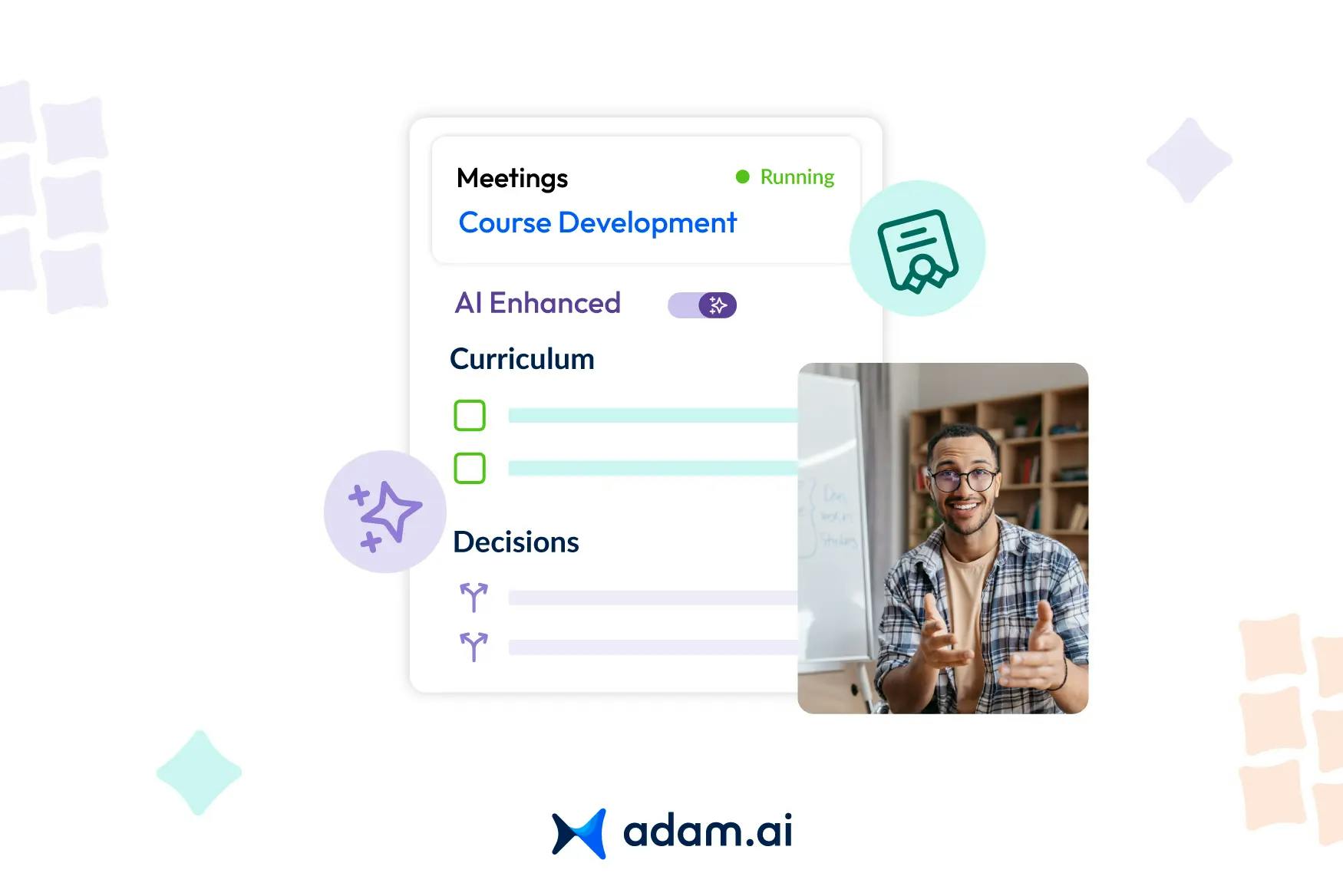
Meetings drag, course planning takes forever, and follow-ups slip through the cracks. AI is changing that. Schools and universities are using AI to simplify course design, automate meeting tasks, and turn discussions into real action. The result? Smarter decisions, less busywork, and a smoother path from planning to execution.
Let's discover how AI is making course development and departmental meetings more efficient, productive, and results-driven.
How is AI redefining course development in educational institutions?
AI is transforming course development by making the process faster, more adaptive, and data-driven, enabling institutions to design engaging, personalized, and scalable learning experiences. From content creation to performance analytics, AI enhances every stage of course design, helping educators focus on teaching rather than administrative burdens.
Automating course design with AI
Institutions are leveraging AI-powered tools to generate course materials, suggest curriculum structures, and align learning objectives with industry demands. AI can analyze student engagement trends, accreditation requirements, and emerging skills to recommend optimized course structures.
For example, Arizona State University (ASU) uses adaptive courseware powered by AI to create modular learning paths for students. This system dynamically adjusts content based on a student’s progress, reinforcing concepts where needed and accelerating learning when mastery is demonstrated. The result is an intelligent, self-adjusting curriculum that adapts to individual learners.
Enhancing content creation and curation
AI can generate course materials, summarize research, and even create interactive elements like quizzes and simulations. AI-driven platforms such as Coursera and Udacity use machine learning to curate relevant resources, recommend supplementary reading materials, and suggest multimedia enhancements based on learner data.
IBM’s AI-powered Watson Tutor has been integrated into higher education programs to analyze vast amounts of educational content, suggest relevant case studies, and create personalized study plans. This eliminates the need for faculty to manually sift through endless resources, ensuring students get targeted and up-to-date material.
Personalizing learning experiences
AI adapts courses based on individual learning styles, past performance, and even real-time engagement. For instance, Carnegie Mellon University’s Open Learning Initiative (OLI) uses AI to personalize coursework, offering customized problem sets, adaptive hints, and data-driven feedback to students.
This personalization is particularly valuable in corporate training programs. Companies like Google and Microsoft use AI-driven learning platforms to deliver tailored courses that adjust in difficulty and content depth based on an employee’s progress. This ensures that every learner engages with material at the right pace, maximizing retention and reducing knowledge gaps.
Automating grading and assessment
AI-driven grading tools save educators hours of administrative work by evaluating quizzes, assignments, and even essays. Turnitin’s AI-based assessment tools not only check for plagiarism but also provide automated feedback on writing quality, coherence, and argument strength.
A prime example is Georgia Tech’s AI teaching assistant, Jill Watson, which handles routine grading and provides immediate responses to students’ questions in online courses. This allows instructors to focus on deeper discussions and higher-order thinking skills while AI takes care of repetitive assessments.
Real-time analytics for course improvement
AI helps institutions analyze student performance trends, identifying gaps in understanding, engagement patterns, and dropout risks. Platforms like Blackboard and Canvas use AI-powered insights to alert educators when students struggle with specific topics or are at risk of disengagement.
For example, the University of Florida implemented an AI-powered analytics system that tracks student engagement and flags potential academic risks. Faculty can intervene early with targeted support, reducing dropout rates and improving student success.
Streamlining course development with AI-powered meeting management
In large institutions, curriculum planning requires collaboration across multiple departments and stakeholders. AI-powered meeting management platforms help synchronize course design discussions, track action items, and streamline approvals.
For example, Harvard Business School uses AI-driven meeting tools to enhance faculty collaboration, ensuring that curriculum updates align with industry shifts and accreditation standards. AI-driven meeting assistants can document key decisions, suggest action points, and retrieve past meeting insights to maintain continuity in course development.
What are the key AI-driven innovations in online course design and content creation?
AI is reshaping online course design by automating content creation, personalizing learning experiences, and improving instructional efficiency. From AI-generated materials to adaptive learning platforms, these innovations streamline the process for educators while enhancing engagement for students.
1. AI-powered course content generation
AI is accelerating content creation by automating the development of lecture materials, quizzes, and assessments.
- Platforms like Coursera and edX use AI to recommend course content, generate learning modules, and suggest related materials based on student interactions.
- AI-powered tools such as ChatGPT and Jasper AI help educators generate course outlines, discussion prompts, and summaries in seconds.
- ScribeSense, an AI-powered grading and content creation tool, assists universities in creating detailed course materials with automated feedback loops.
🔹Example: At Harvard University, AI is being used to generate course summaries and personalize learning modules in large online courses, allowing instructors to focus on student engagement rather than manual content creation.
2. Adaptive learning systems for personalized education
AI-driven adaptive learning platforms tailor course content to individual student needs by analyzing their engagement, learning pace, and performance.
- Knewton and Smart Sparrow use AI algorithms to adjust course difficulty, recommend supplementary materials, and provide real-time feedback.
- AI-powered learning management systems (LMS) like Blackboard and Canvas personalize coursework by tracking student behavior and engagement.
🔹Example: Arizona State University (ASU) partnered with adaptive learning company CogBooks, allowing AI to identify student struggles and suggest targeted interventions in online courses. As a result, ASU improved student pass rates in introductory biology courses by 18%.
3. AI-generated interactive content and simulations
AI can create immersive learning experiences by designing interactive videos, virtual labs, and real-world simulations.
- Labster, a virtual science lab powered by AI, allows students to conduct complex experiments in an online setting.
- AI-driven tools like Synthesia generate video lectures with AI avatars, reducing the time and cost of content production for online instructors.
- AI-powered chatbots, such as IBM Watson Tutor, act as virtual tutors, engaging students in simulated case studies and real-world scenarios.
🔹Example: Georgia Institute of Technology integrated Jill Watson into its online master’s program, answering students’ questions with 97% accuracy and reducing faculty workload.
4. AI-powered assessment and feedback tools
AI-driven assessment tools are revolutionizing how educators evaluate student progress by automating grading and providing real-time feedback.
- Gradescope by Turnitin leverages AI to grade handwritten exams, coding assignments, and multiple-choice tests, significantly reducing grading time.
- AI-based writing assistants like Grammarly and Turnitin’s Revision Assistant provide students with instant feedback on grammar, style, and clarity.
🔹Example: The University of Florida implemented AI-driven grading systems that reduced faculty grading time by 40%, allowing professors to spend more time mentoring students.
5. AI-powered accessibility and language translation
AI tools are making online courses more inclusive by offering automatic translations, speech-to-text transcription, and text simplification.
- AI-driven captioning tools like Otter.ai and Rev AI provide real-time lecture transcriptions for students with hearing impairments.
- Duolingo and Google Translate’s AI engines assist students in translating academic content into multiple languages.
🔹Example: The University of Toronto integrated AI-powered real-time translation and text-to-speech features into its online courses, ensuring that non-native English speakers can engage with materials in their preferred language.
6. AI-driven predictive analytics for course optimization
AI helps institutions analyze student engagement trends, dropout risks, and course effectiveness by tracking participation and assessment data.
- EdTech platforms like Brightspace by D2L use AI-driven analytics to predict student performance and suggest instructional interventions.
- AI-powered dashboards in Canvas and Blackboard allow faculty to track which students are struggling and provide personalized support.
🔹Example: The University of Michigan uses AI-powered predictive analytics to flag at-risk students early in the semester, allowing faculty to intervene and improve retention rates.
How can AI assist in curriculum planning and personalization for diverse learners?
AI is advancing curriculum planning by making it more dynamic, data-driven, and tailored to individual learners. Through automation, predictive analytics, and adaptive learning technologies, AI helps institutions optimize course structures and personalize education at scale.
1. AI-driven curriculum mapping and optimization
AI helps educators design better-aligned and structured curricula by analyzing student performance trends, accreditation standards, and emerging skills in the job market. It identifies redundant content, knowledge gaps, and underutilized learning materials to ensure course content is effective and relevant. By automating the curriculum planning process, institutions can create efficient learning pathways that evolve with educational needs.
2. Personalized learning paths for individual students
AI enables adaptive learning experiences, ensuring that students progress at their own pace while receiving customized support. AI-driven platforms adjust coursework based on real-time student interactions, strengths, and weaknesses. Some learners may receive additional practice on challenging concepts, while others may be accelerated through mastered topics. This individualized approach improves engagement and retention by catering to different learning speeds and styles.
3. AI-powered support for diverse learners and special needs education
AI enhances inclusivity by providing personalized assistance for students with different learning needs. Institutions implementing AI in course development should ensure their strategies align with inclusive education policies to support diverse learners effectively.
Tools such as speech-to-text, automatic translations, and reading level adjustments help learners overcome barriers related to language, disabilities, or unique learning preferences. AI can suggest alternative explanations, visual aids, or interactive exercises that suit different cognitive styles, ensuring every student has an equal opportunity to succeed.
4. AI in competency-based learning and skill development
AI helps institutions transition from traditional time-based learning models to competency-based education. Instead of progressing based on fixed schedules, students can advance when they demonstrate mastery of specific skills. AI analyzes learning behaviors and assessment performance to recommend targeted modules or additional resources, ensuring that students develop the right competencies for their academic or career goals.
5. Predictive analytics for early intervention and retention
AI detects patterns of student disengagement, declining performance, or missed coursework to identify those at risk of falling behind or dropping out. Educators receive real-time alerts, allowing them to intervene with personalized support strategies such as tutoring recommendations, additional study materials, or flexible deadlines. This proactive approach helps institutions improve retention rates and student success.
6. AI in faculty decision-making for curriculum updates
AI assists educators in evaluating and improving course effectiveness by analyzing student feedback, engagement metrics, and completion rates. Leveraging AI in collaborative educational partnerships ensures curriculum updates reflect real-world industry needs and evolving student requirements. It helps faculties determine which topics need enhancements, removals, or updates to align with academic standards and industry trends.
AI-driven insights allow institutions to maintain high-quality, relevant curricula without requiring constant manual review. Integrating AI into educational leadership strategies ensures that academic programs remain forward-thinking and aligned with institutional goals.
What role does AI play in optimizing assessment and grading processes?
AI is reshaping assessment and grading by enhancing efficiency, accuracy, and adaptability. It automates evaluation, minimizes human error, and personalizes feedback, allowing educators to streamline their workload while improving student learning outcomes.
1. Automated grading for efficiency
AI-powered grading tools can process quizzes, short-answer responses, and essays with precision. These systems use machine learning and natural language processing (NLP) to assess grammar, coherence, argumentation, and concept mastery. By handling routine grading tasks, AI frees up educators to focus on student engagement and instruction.
2. Objective and consistent evaluation
Unlike traditional grading, which can be subjective and inconsistent, AI ensures that assessments are scored uniformly based on predefined criteria. This reduces grading discrepancies, eliminates unconscious biases, and improves reliability in evaluating student work.
3. Personalized feedback for students
AI-driven assessment platforms provide instant, tailored feedback, enabling students to identify areas for improvement immediately. Instead of waiting days for feedback, learners can revise their work in real time, fostering a more interactive and self-directed learning process.
4. AI in adaptive assessments
AI enables customized testing experiences by adjusting question difficulty in real time based on student responses. If a student struggles with a concept, the system offers simpler explanations and additional resources. Conversely, high-performing students receive more advanced questions, ensuring that assessments accurately reflect each learner’s capabilities.
5. Detecting plagiarism and academic integrity issues
AI-powered tools analyze text originality, citation accuracy, and content structure to detect potential plagiarism or misuse of AI-generated responses. Advanced AI tools also use NLP in meetings for stakeholder sentiment to gauge engagement levels and refine decision-making processes. These systems help safeguard academic integrity by ensuring that students produce original, well-researched work.
6. Predictive analytics for student performance tracking
Beyond grading, AI can identify learning trends and potential academic risks. By analyzing student performance patterns, AI can predict which students may struggle, suggest targeted interventions, and provide educators with actionable insights to enhance learning support strategies.
How can AI improve the structure and productivity of departmental meetings?
AI is refining the way departmental meetings are organized, conducted, and followed up, making them more structured, time-efficient, and results-driven. By automating administrative tasks, enhancing collaboration, and providing data-driven insights, AI helps minimize inefficiencies and improve decision-making.
1. Smart agenda planning and optimization
AI-driven tools help create well-structured meeting agendas by analyzing past meetings, identifying recurring discussion points, and prioritizing urgent topics. Institutions leveraging machine learning in meeting preparation can ensure agendas stay relevant, well-structured, and aligned with institutional priorities.
AI can suggest agenda templates, allocate time slots based on topic importance, and flag unfinished discussions from previous meetings. This ensures meetings stay focused and productive.
2. AI-powered meeting summarization and note-taking
AI eliminates the need for manual note-taking by transcribing discussions in real time and summarizing key points. Meeting assistants can automatically generate concise minutes, highlight action items, and extract important decisions, ensuring that participants have a clear record of discussions without distractions. AI-powered faculty and administration AI meetings help institutions document critical discussions and ensure follow-ups lead to meaningful action.
3. Automated task assignment and follow-ups
AI enhances accountability by tracking assigned tasks and sending automated follow-ups. After a meeting, AI can summarize who is responsible for what, set deadlines, and integrate tasks with project management tools. This ensures that action points don’t get lost and that progress is monitored.
4. Intelligent scheduling and time management
AI-powered scheduling tools analyze team availability, time zones, and meeting priorities to suggest the most efficient time slots. By optimizing schedules and cutting down unnecessary discussions, institutions can achieve better ROI through reduced meeting time. AI can also detect overlapping commitments, suggest shorter durations based on past meeting patterns, and recommend alternatives to avoid unnecessary gatherings.
5. Data-driven insights for meeting efficiency
AI tools can assess meeting patterns, engagement levels, and decision-making efficiency over time. By analyzing metrics such as meeting length, participation rates, and frequency of unresolved discussions, AI helps teams refine their approach to meetings, ensuring that time is used effectively. Institutions using meeting analytics for student success can further refine their meeting structures to drive measurable improvements in learning outcomes.
6. AI-powered collaboration for hybrid and remote teams
For remote or hybrid teams, AI enhances engagement through real-time translations, speaker identification, and virtual collaboration tools. AI-powered platforms enable seamless participation, ensuring that all voices are heard and documented, regardless of location. This ensures that stakeholder engagement in university meetings remains strong, even in hybrid or fully remote settings.
How does AI enhance decision-making and strategic planning in educational departments?
AI gives education leaders clearer insights, faster analysis, and better predictions. Instead of relying on outdated reports or guesswork, they get real-time data on student performance, resource allocation, and faculty needs. AI-driven insights are becoming essential in education administration, allowing institutions to streamline decision-making and optimize resources efficiently. That means smarter decisions and stronger long-term strategies.
1. Real-time data for smarter decisions
Most institutions work with annual reports or delayed assessments. AI changes that. It continuously pulls data on enrollment trends, student engagement, and curriculum effectiveness. Leaders can spot issues as they happen instead of waiting until the semester is over.
2. Predicting student success and dropout risks
AI identifies patterns in student performance and flags early signs of struggle. That way, faculty and administrators can step in before students fail or drop out. Schools using AI-powered retention tools see higher graduation rates and fewer last-minute interventions.
3. Optimizing resource allocation
Budgeting and staffing decisions get easier with AI. Schools can also integrate AI into school budget meetings to make data-driven financial decisions that align with faculty and student needs. It analyzes class sizes, faculty workloads, and course demand to suggest the most efficient way to use resources. Instead of overloading some professors while others have empty classrooms, schools can balance schedules automatically.
4. Improving curriculum and program planning
What courses need updates? Where are students struggling the most? AI tracks student performance across subjects and highlights areas for improvement. Stronger university-industry partnerships also benefit from AI-driven insights, ensuring students develop skills relevant to today’s job market. If many students fail a particular module, AI can suggest adjustments to teaching methods or curriculum content.
5. Faster, more accurate strategic planning
Long-term planning used to involve guesswork and outdated benchmarks. AI makes it precise. Schools can model different scenarios, like how shifting funding to online learning might impact enrollment or whether adding a new major would attract more students. AI-driven insights also help in aligning educational goals with institutional priorities, making long-term strategies more effective.
What are the potential risks and limitations of using AI in course development and meetings?
AI makes course development and meetings faster and more structured, but it’s not perfect. There are risks, and ignoring them can create bigger problems than the ones AI was meant to solve.
1. Lack of human oversight
AI can suggest course content, generate meeting summaries, and even grade assignments. But it doesn’t understand nuance. It might pull outdated information, misinterpret a discussion, or fail to recognize when a course design isn’t engaging. Relying too much on AI can lead to errors that no one catches in time.
2. Bias in AI algorithms
AI learns from existing data, and that data isn’t always neutral. If past hiring or grading patterns have been biased, AI can repeat those same mistakes. In course development, it might recommend reading materials that exclude diverse perspectives or favor certain teaching styles over others.
3. Over-reliance on automation
It’s tempting to let AI handle everything: course scheduling, meeting planning, and grading. But when decisions are fully automated, critical thinking gets lost. Professors, administrators, and students might trust AI blindly instead of questioning its recommendations.
4. Data privacy and security concerns
AI in education collects huge amounts of data, from student performance to meeting discussions. Who has access? How is it protected? Without strict policies, sensitive information could be leaked or misused.
5. Reduced Personal Interaction
In meetings, AI helps with summaries and tracking decisions, but it can’t replace real discussions. If teams rely too much on AI-generated reports, important context can be lost. The same goes for education; AI can’t replace real-time student-teacher interactions.
6. High Implementation Costs
AI isn’t plug-and-play. Schools and organizations need the right tools, training, and support to make it work. If budgets are tight, AI might end up being a costly experiment that doesn’t deliver the expected results.
How can institutions ensure ethical and unbiased AI implementation in education?
AI can improve learning and streamline administration, but it’s only as good as the data and rules behind it. If institutions don’t set the right guidelines, AI can reinforce biases, mishandle student data, or make unfair decisions. Keeping AI ethical and unbiased takes deliberate action.
1. Audit AI for bias regularly
AI learns from historical data. If past grading patterns, admissions decisions, or hiring trends have been biased, AI will amplify those biases. Institutions should review AI recommendations frequently, test for disparities, and adjust algorithms to ensure fairness.
2. Keep humans in the loop
AI should support, not replace, human decision-making. Whether it’s grading assignments, analyzing student success rates, or summarizing meetings, there must be human oversight. Educators and administrators should double-check AI-generated insights before acting on them.
3. Be transparent about AI use
Students, faculty, and staff should know when and how AI is being used. If AI is making grading suggestions or tracking participation, educators should explain how it works and how students can challenge unfair outcomes. Transparency builds trust and prevents misuse. AI-driven meeting tools also ensure accountability in school board meetings, helping institutions maintain ethical oversight in decision-making processes.
4. Protect student data
AI collects and analyzes vast amounts of information—grades, attendance, meeting transcripts, even behavioral trends. Institutions must have strict data privacy policies to prevent misuse. That includes clear guidelines on data storage, encryption, and who has access.
5. Train staff and faculty on ethical AI use
AI tools are only as ethical as the people using them. Institutions should educate faculty and administrators on the risks of algorithmic bias, data privacy concerns, and over-reliance on automation. The more informed the staff, the better they can spot and prevent AI-related issues.
6. Allow appeals for AI-generated decisions
If AI is involved in grading, admissions, or scheduling, students and staff should have a way to challenge its decisions. Institutions need a clear appeals process to review AI-driven outcomes and make human adjustments when needed.
7. Choose ethical AI vendors
Not all AI tools are built with fairness in mind. Schools should work with vendors that prioritize bias detection, transparency, and data security. Asking tough questions before adopting AI prevents ethical problems down the line.
How does adam.ai empower educational institutions to run course development and meetings efficiently?
Meetings and course planning can get messy. Too many discussions, lost notes, and no follow-ups. adam.ai fixes that by keeping agendas structured, collaboration seamless, and decisions actionable. Everything stays in one place, so teams stay organized and get things done.
1. Agenda management keeps meetings focused
Without a clear agenda, meetings waste time and go off track. adam.ai allows institutions to set structured agendas, assign topics to team members, and allocate time for discussions.
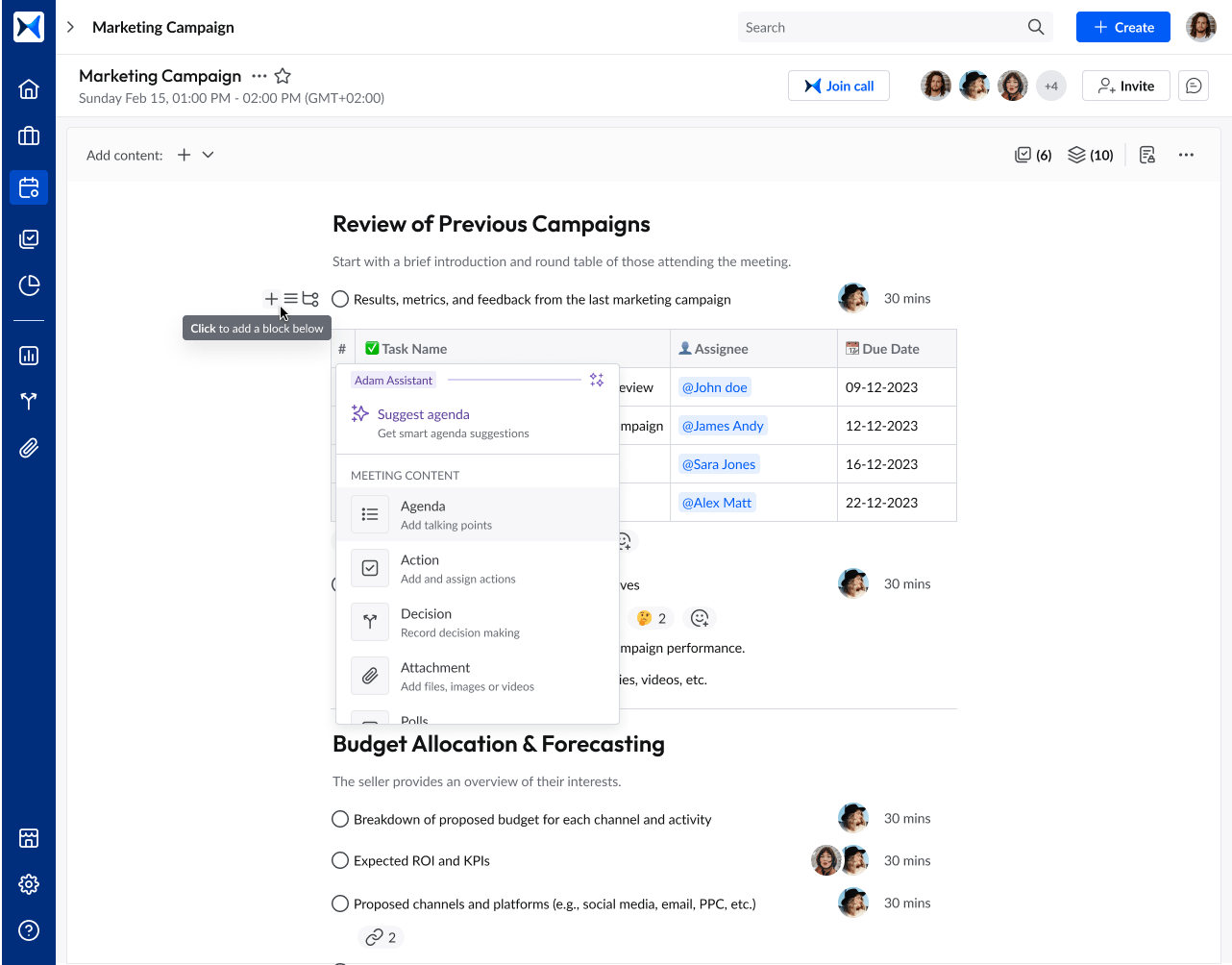
2. Content collaboration centralizes course materials
Course development requires faculty, instructional designers, and administrators to work together. adam.ai helps teams store and access shared documents, meeting notes, and curriculum plans in one place.
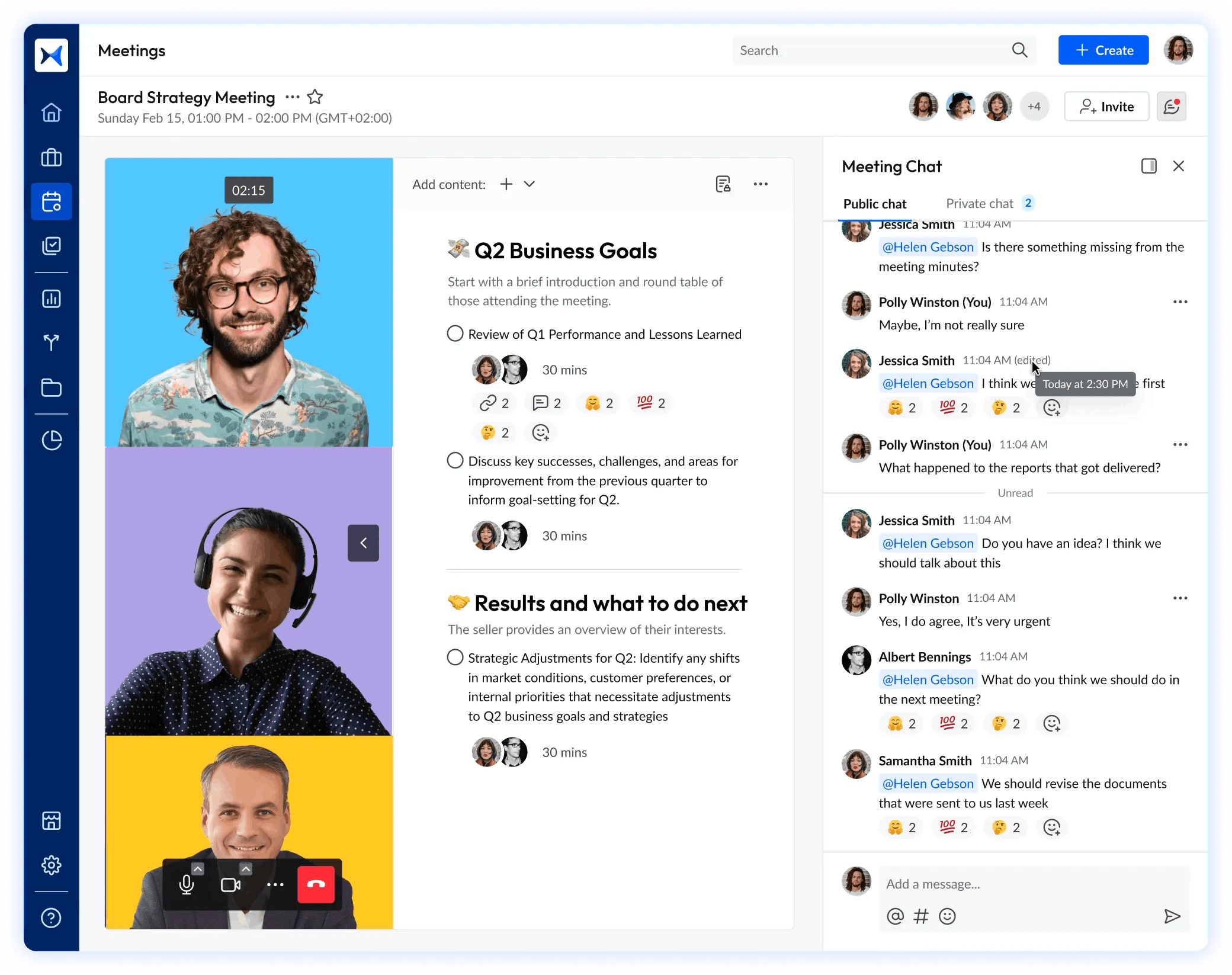
3. Action tracking and management ensures follow-through
Decisions mean nothing if no one follows up. adam.ai assigns action items to the right people, sets deadlines, and tracks progress automatically. Whether it’s updating a course syllabus, finalizing an accreditation report, or implementing new policies, nothing falls through the cracks.
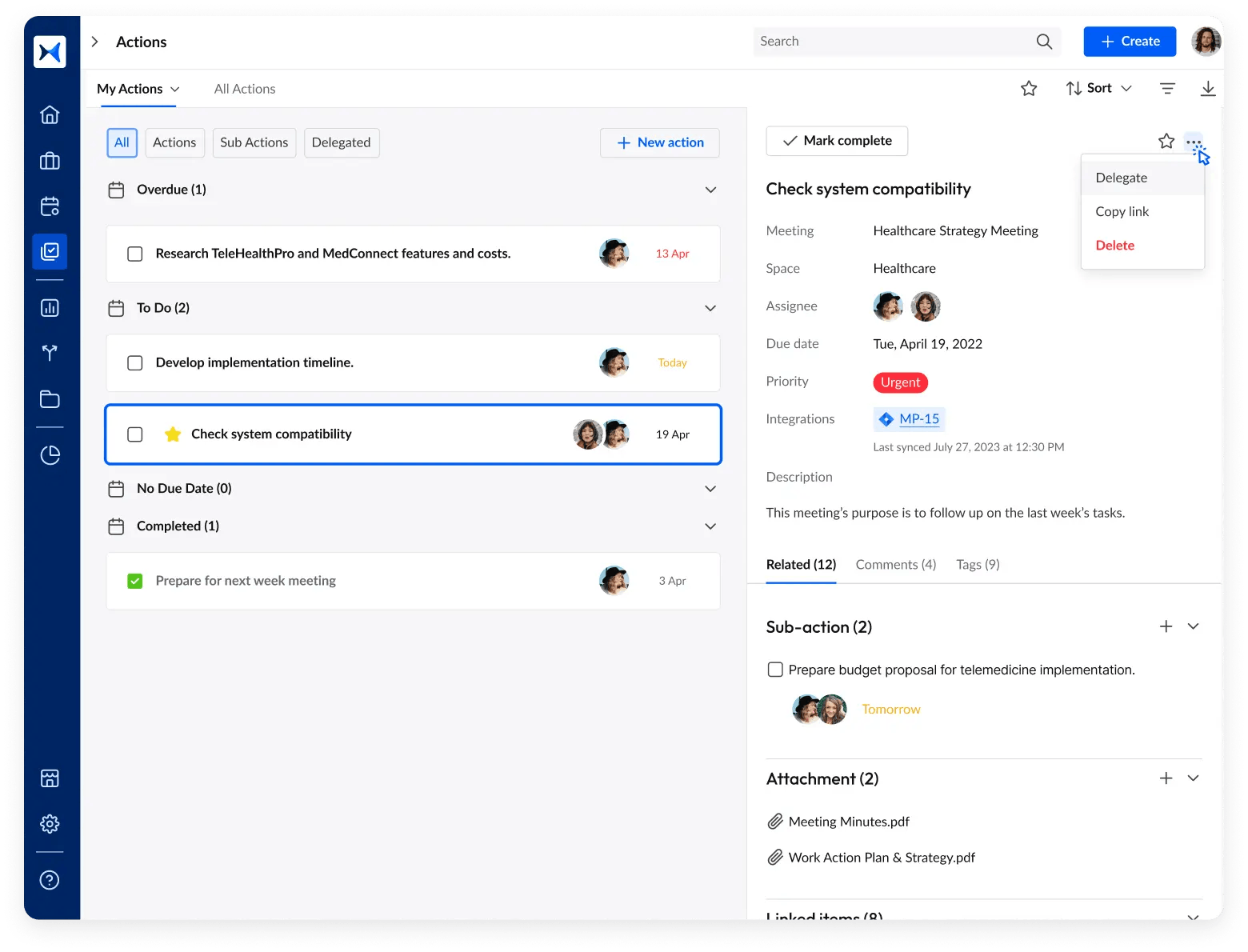
4. Meeting minutes capture key decisions
Faculty meetings, curriculum planning sessions, and committee discussions generate important takeaways. adam.ai automatically records meeting summaries, key insights, and next steps, ensuring that everyone stays aligned, even those who couldn’t attend.
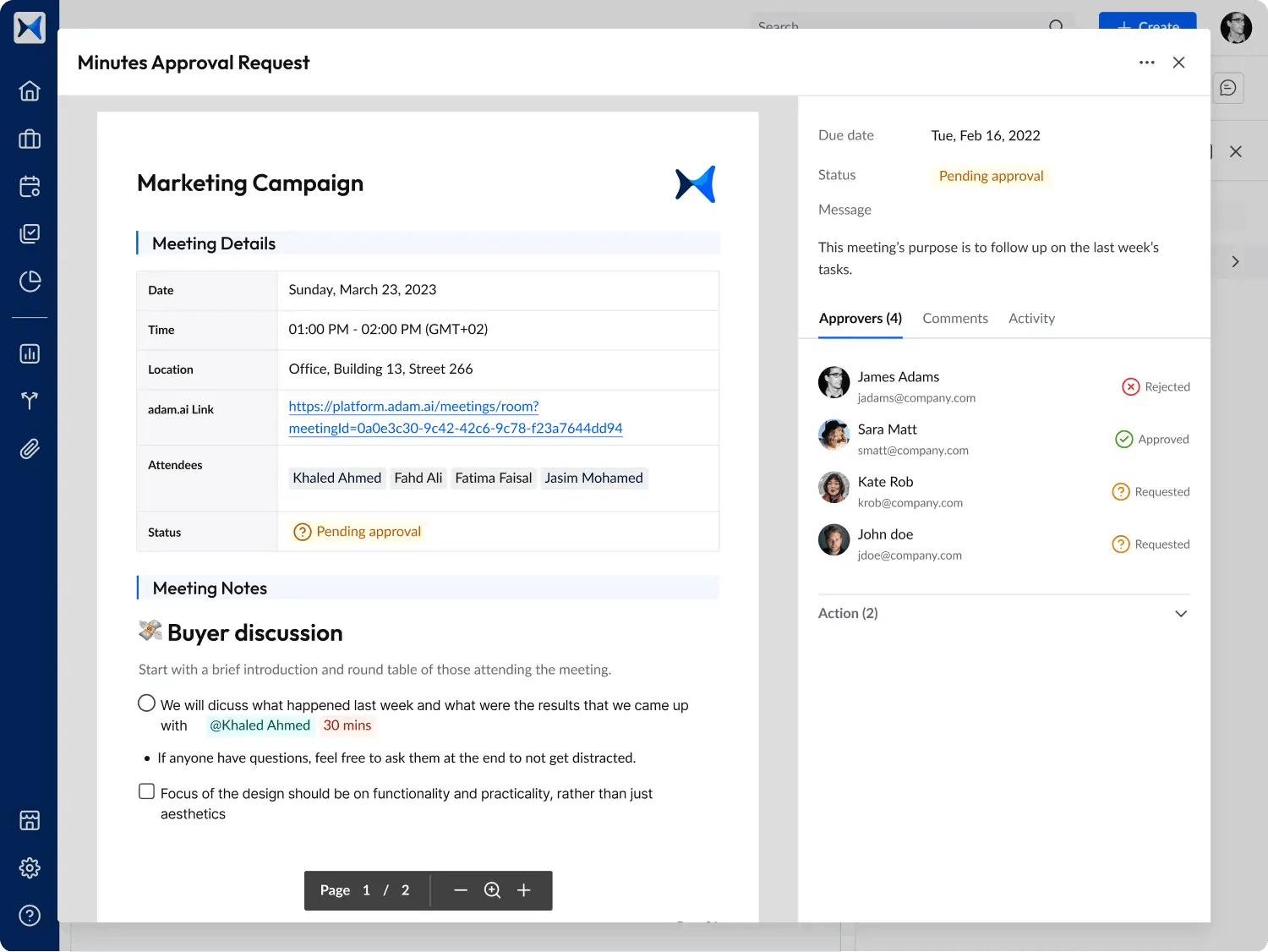
5. Analytical dashboards provide data-driven insights
Institutions make better decisions when they see trends over time. adam.ai’s dashboards provide insights on meeting frequency, completion rates of action items, and participation levels. Schools can identify bottlenecks, streamline decision-making, and continuously improve meeting effectiveness.
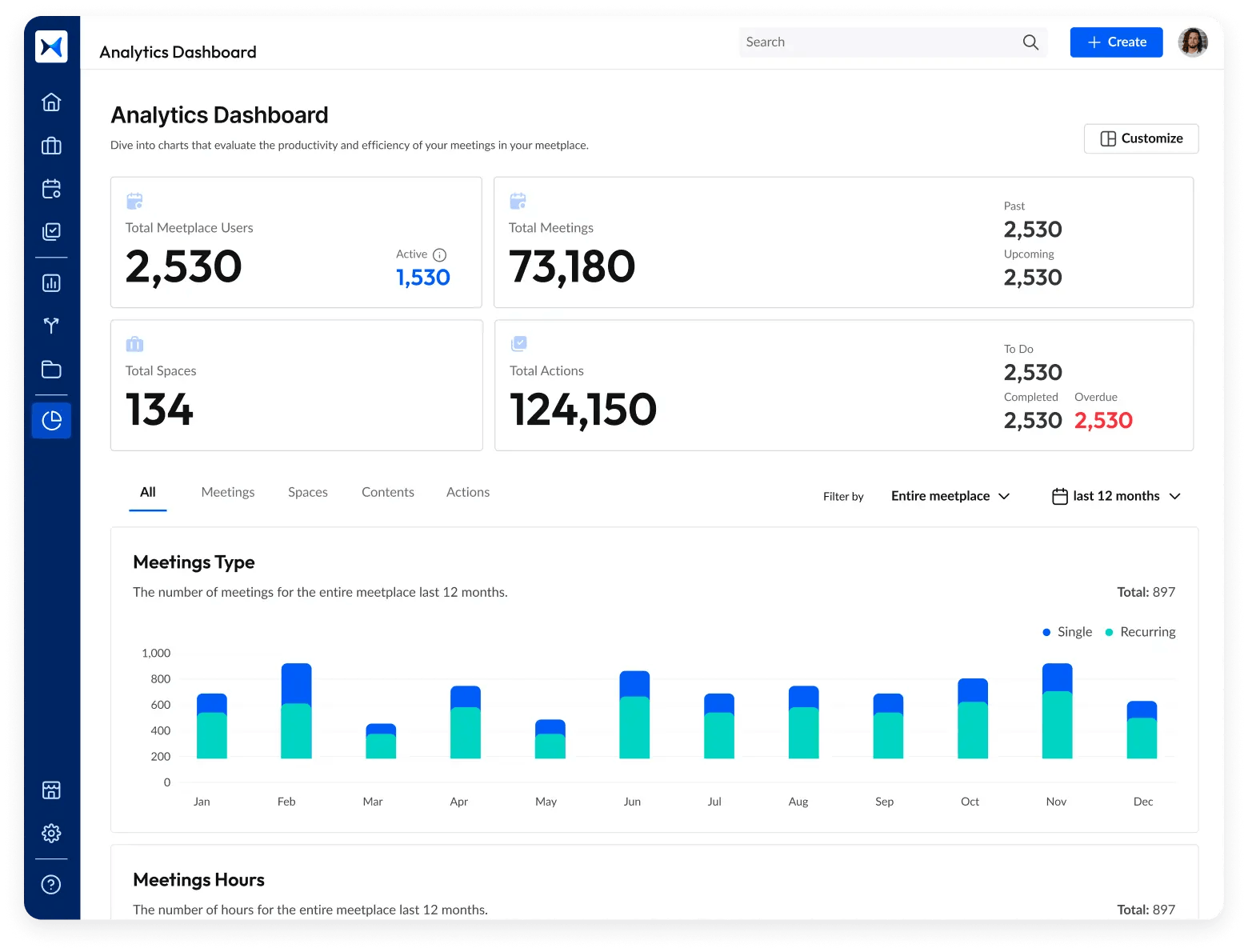
Transform how you conduct critical meetings—From meticulous preparation to effective execution and insightful follow-up, adam.ai integrates comprehensive analytics, full customization, and intuitive interfaces with powerful meeting management tools.
Easy onboarding. Enterprise-grade security. 24/7 dedicated support.
The bottom line
AI is taking the hassle out of course development and departmental meetings. From structuring agendas and automating follow-ups to improving collaboration and tracking progress, AI helps educational institutions work smarter, not harder. Schools that embrace AI save time, make better decisions, and turn meetings into real progress.
And while there may be multiple solutions available, here is why adam.ai is the meeting management software platform you can trust:
- adam.ai is one of Atlassian Ventures' portfolio companies.
- In the meeting management software category on G2, adam.ai has been ranked a leader and a high performer for successive quarters in the past years.
- adam.ai has been included in the Forrester Report in the AI-enabled meeting technology landscape.
- adam.ai is trusted and used by powerful teams and organizations worldwide for all types of critical meetings, like board, committee, project management, and business development meetings.
- And most importantly, adam.ai integrates with your existing workflow, is SOC2 compliant, provides dedicated support and success, and has a free trial option.
Subscribe to adam.ai blog
Stay ahead with the latest insights—get our newest blog posts, tips, and updates sent straight to your inbox.